Analyzing the Baltic Pipe Project's Impact on EU and UK Energy
VerifiedAdded on 2021/04/17
|9
|2108
|23
Report
AI Summary
This report provides a comprehensive analysis of the Baltic Pipe Project, examining its influence on the energy sectors of the European Union (EU) and the United Kingdom (UK). The study delves into the project's role in diversifying energy supplies, reducing reliance on Russian gas, and promoting the adoption of renewable energy sources. It explores the geopolitical implications, economic benefits, and technological advancements associated with the pipeline, highlighting the project's significance for energy security and sustainability. The report also considers the political factors, environmental impact assessments, and regulatory frameworks involved in the construction and operation of the Baltic Pipe. The report discusses the impact of Brexit on the project, alongside the project’s influence on the socio-economic conditions of the countries involved. Furthermore, the report provides an overview of the project's development, including the involvement of key stakeholders, the assessment of environmental impacts, and adherence to EU policies. It also includes an appendix with a visual representation of the Baltic Pipeline to provide a better understanding of the project.

Running head: GLOBAL ENERGY
GLOBAL ENERGY
Name of the student
Name of the university
Author note
GLOBAL ENERGY
Name of the student
Name of the university
Author note
Paraphrase This Document
Need a fresh take? Get an instant paraphrase of this document with our AI Paraphraser
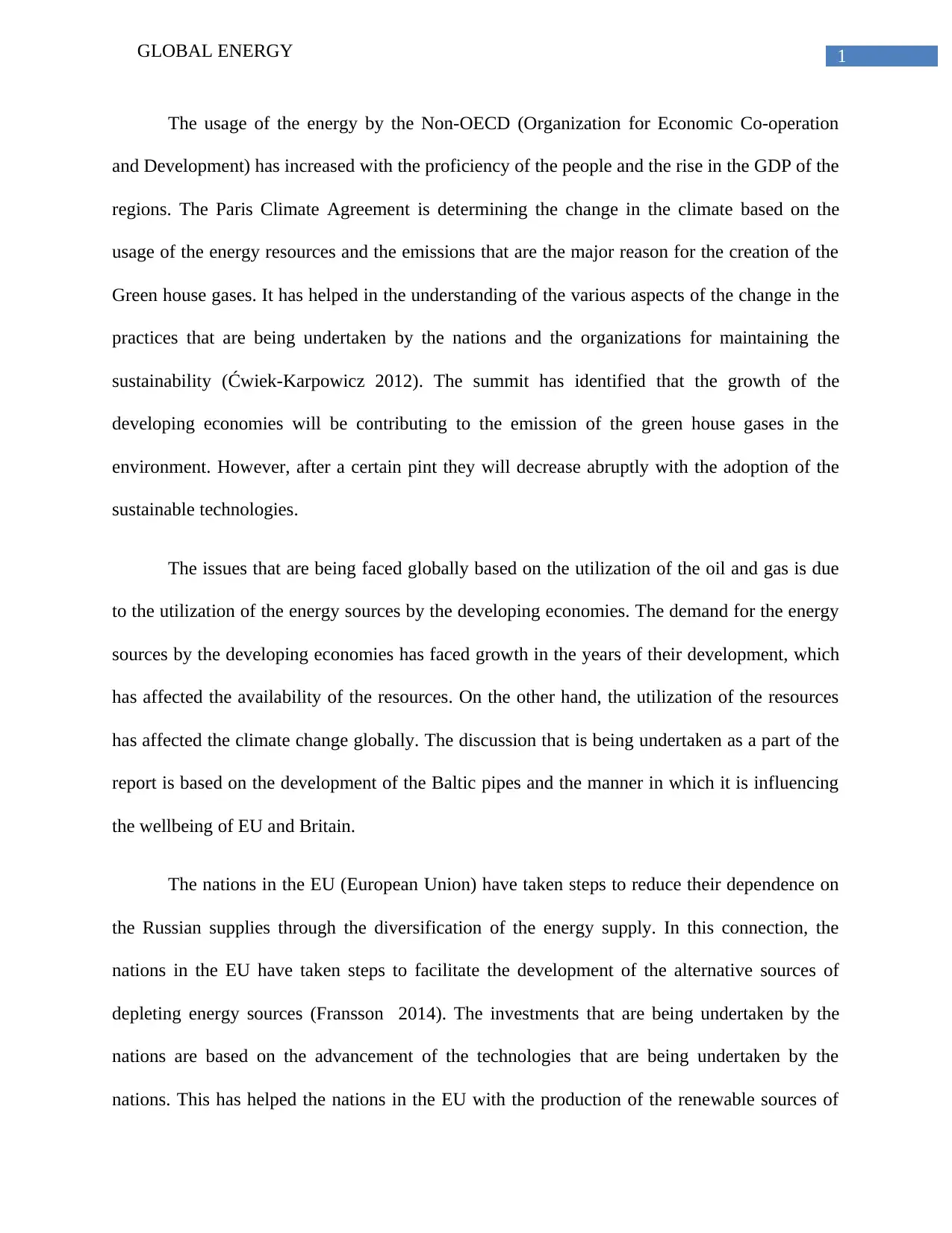
1GLOBAL ENERGY
The usage of the energy by the Non-OECD (Organization for Economic Co-operation
and Development) has increased with the proficiency of the people and the rise in the GDP of the
regions. The Paris Climate Agreement is determining the change in the climate based on the
usage of the energy resources and the emissions that are the major reason for the creation of the
Green house gases. It has helped in the understanding of the various aspects of the change in the
practices that are being undertaken by the nations and the organizations for maintaining the
sustainability (Ćwiek-Karpowicz 2012). The summit has identified that the growth of the
developing economies will be contributing to the emission of the green house gases in the
environment. However, after a certain pint they will decrease abruptly with the adoption of the
sustainable technologies.
The issues that are being faced globally based on the utilization of the oil and gas is due
to the utilization of the energy sources by the developing economies. The demand for the energy
sources by the developing economies has faced growth in the years of their development, which
has affected the availability of the resources. On the other hand, the utilization of the resources
has affected the climate change globally. The discussion that is being undertaken as a part of the
report is based on the development of the Baltic pipes and the manner in which it is influencing
the wellbeing of EU and Britain.
The nations in the EU (European Union) have taken steps to reduce their dependence on
the Russian supplies through the diversification of the energy supply. In this connection, the
nations in the EU have taken steps to facilitate the development of the alternative sources of
depleting energy sources (Fransson 2014). The investments that are being undertaken by the
nations are based on the advancement of the technologies that are being undertaken by the
nations. This has helped the nations in the EU with the production of the renewable sources of
The usage of the energy by the Non-OECD (Organization for Economic Co-operation
and Development) has increased with the proficiency of the people and the rise in the GDP of the
regions. The Paris Climate Agreement is determining the change in the climate based on the
usage of the energy resources and the emissions that are the major reason for the creation of the
Green house gases. It has helped in the understanding of the various aspects of the change in the
practices that are being undertaken by the nations and the organizations for maintaining the
sustainability (Ćwiek-Karpowicz 2012). The summit has identified that the growth of the
developing economies will be contributing to the emission of the green house gases in the
environment. However, after a certain pint they will decrease abruptly with the adoption of the
sustainable technologies.
The issues that are being faced globally based on the utilization of the oil and gas is due
to the utilization of the energy sources by the developing economies. The demand for the energy
sources by the developing economies has faced growth in the years of their development, which
has affected the availability of the resources. On the other hand, the utilization of the resources
has affected the climate change globally. The discussion that is being undertaken as a part of the
report is based on the development of the Baltic pipes and the manner in which it is influencing
the wellbeing of EU and Britain.
The nations in the EU (European Union) have taken steps to reduce their dependence on
the Russian supplies through the diversification of the energy supply. In this connection, the
nations in the EU have taken steps to facilitate the development of the alternative sources of
depleting energy sources (Fransson 2014). The investments that are being undertaken by the
nations are based on the advancement of the technologies that are being undertaken by the
nations. This has helped the nations in the EU with the production of the renewable sources of
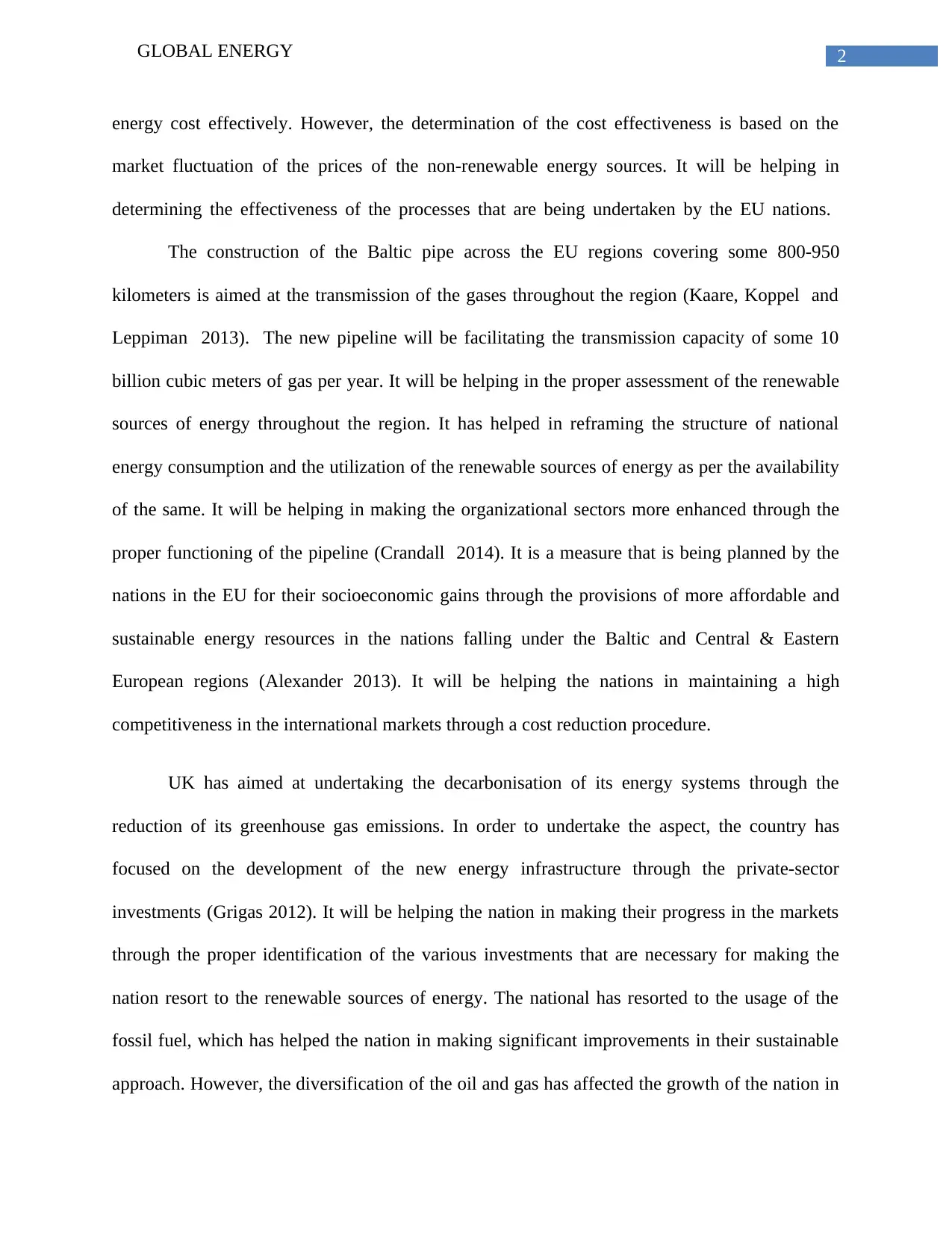
2GLOBAL ENERGY
energy cost effectively. However, the determination of the cost effectiveness is based on the
market fluctuation of the prices of the non-renewable energy sources. It will be helping in
determining the effectiveness of the processes that are being undertaken by the EU nations.
The construction of the Baltic pipe across the EU regions covering some 800-950
kilometers is aimed at the transmission of the gases throughout the region (Kaare, Koppel and
Leppiman 2013). The new pipeline will be facilitating the transmission capacity of some 10
billion cubic meters of gas per year. It will be helping in the proper assessment of the renewable
sources of energy throughout the region. It has helped in reframing the structure of national
energy consumption and the utilization of the renewable sources of energy as per the availability
of the same. It will be helping in making the organizational sectors more enhanced through the
proper functioning of the pipeline (Crandall 2014). It is a measure that is being planned by the
nations in the EU for their socioeconomic gains through the provisions of more affordable and
sustainable energy resources in the nations falling under the Baltic and Central & Eastern
European regions (Alexander 2013). It will be helping the nations in maintaining a high
competitiveness in the international markets through a cost reduction procedure.
UK has aimed at undertaking the decarbonisation of its energy systems through the
reduction of its greenhouse gas emissions. In order to undertake the aspect, the country has
focused on the development of the new energy infrastructure through the private-sector
investments (Grigas 2012). It will be helping the nation in making their progress in the markets
through the proper identification of the various investments that are necessary for making the
nation resort to the renewable sources of energy. The national has resorted to the usage of the
fossil fuel, which has helped the nation in making significant improvements in their sustainable
approach. However, the diversification of the oil and gas has affected the growth of the nation in
energy cost effectively. However, the determination of the cost effectiveness is based on the
market fluctuation of the prices of the non-renewable energy sources. It will be helping in
determining the effectiveness of the processes that are being undertaken by the EU nations.
The construction of the Baltic pipe across the EU regions covering some 800-950
kilometers is aimed at the transmission of the gases throughout the region (Kaare, Koppel and
Leppiman 2013). The new pipeline will be facilitating the transmission capacity of some 10
billion cubic meters of gas per year. It will be helping in the proper assessment of the renewable
sources of energy throughout the region. It has helped in reframing the structure of national
energy consumption and the utilization of the renewable sources of energy as per the availability
of the same. It will be helping in making the organizational sectors more enhanced through the
proper functioning of the pipeline (Crandall 2014). It is a measure that is being planned by the
nations in the EU for their socioeconomic gains through the provisions of more affordable and
sustainable energy resources in the nations falling under the Baltic and Central & Eastern
European regions (Alexander 2013). It will be helping the nations in maintaining a high
competitiveness in the international markets through a cost reduction procedure.
UK has aimed at undertaking the decarbonisation of its energy systems through the
reduction of its greenhouse gas emissions. In order to undertake the aspect, the country has
focused on the development of the new energy infrastructure through the private-sector
investments (Grigas 2012). It will be helping the nation in making their progress in the markets
through the proper identification of the various investments that are necessary for making the
nation resort to the renewable sources of energy. The national has resorted to the usage of the
fossil fuel, which has helped the nation in making significant improvements in their sustainable
approach. However, the diversification of the oil and gas has affected the growth of the nation in
⊘ This is a preview!⊘
Do you want full access?
Subscribe today to unlock all pages.

Trusted by 1+ million students worldwide
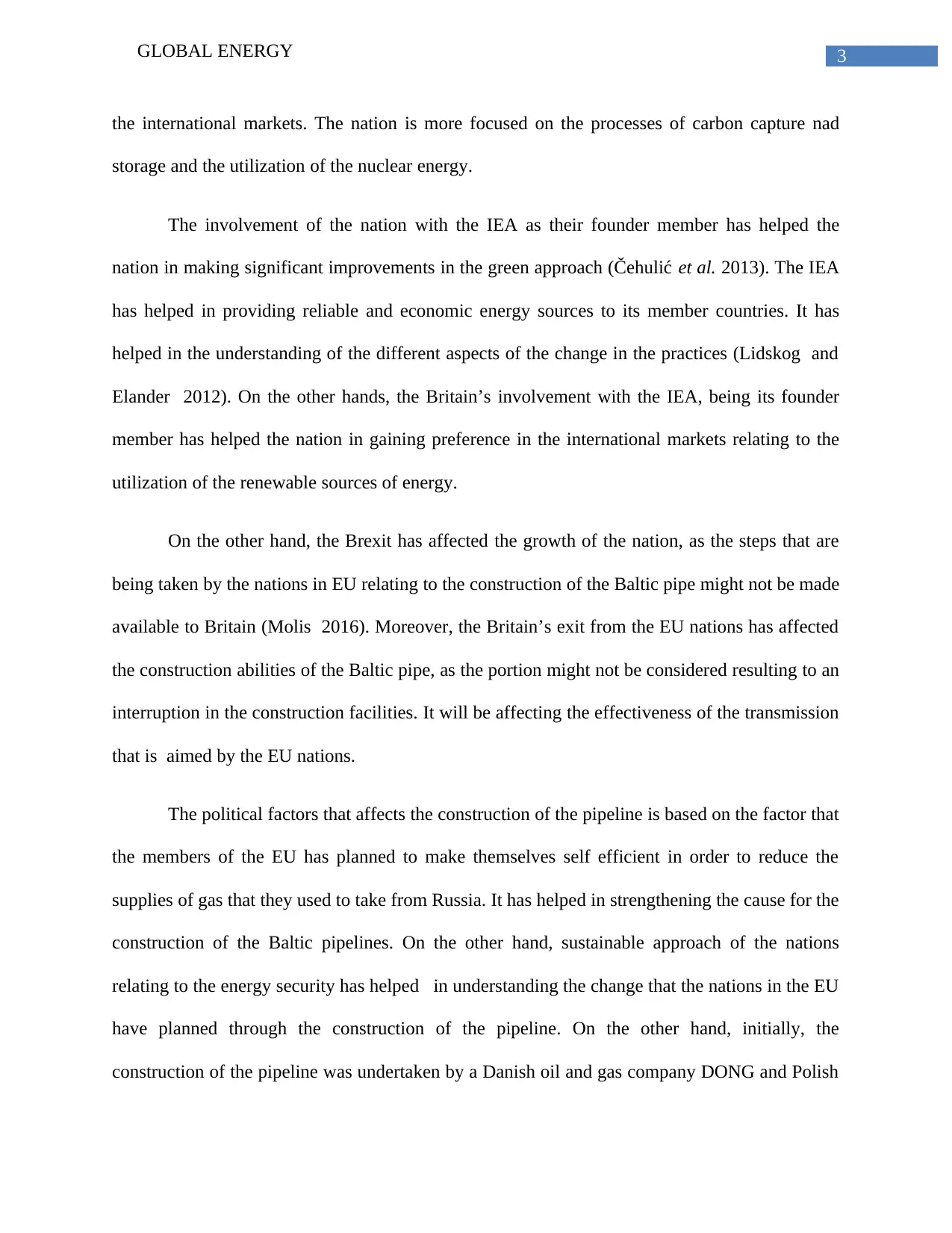
3GLOBAL ENERGY
the international markets. The nation is more focused on the processes of carbon capture nad
storage and the utilization of the nuclear energy.
The involvement of the nation with the IEA as their founder member has helped the
nation in making significant improvements in the green approach (Čehulić et al. 2013). The IEA
has helped in providing reliable and economic energy sources to its member countries. It has
helped in the understanding of the different aspects of the change in the practices (Lidskog and
Elander 2012). On the other hands, the Britain’s involvement with the IEA, being its founder
member has helped the nation in gaining preference in the international markets relating to the
utilization of the renewable sources of energy.
On the other hand, the Brexit has affected the growth of the nation, as the steps that are
being taken by the nations in EU relating to the construction of the Baltic pipe might not be made
available to Britain (Molis 2016). Moreover, the Britain’s exit from the EU nations has affected
the construction abilities of the Baltic pipe, as the portion might not be considered resulting to an
interruption in the construction facilities. It will be affecting the effectiveness of the transmission
that is aimed by the EU nations.
The political factors that affects the construction of the pipeline is based on the factor that
the members of the EU has planned to make themselves self efficient in order to reduce the
supplies of gas that they used to take from Russia. It has helped in strengthening the cause for the
construction of the Baltic pipelines. On the other hand, sustainable approach of the nations
relating to the energy security has helped in understanding the change that the nations in the EU
have planned through the construction of the pipeline. On the other hand, initially, the
construction of the pipeline was undertaken by a Danish oil and gas company DONG and Polish
the international markets. The nation is more focused on the processes of carbon capture nad
storage and the utilization of the nuclear energy.
The involvement of the nation with the IEA as their founder member has helped the
nation in making significant improvements in the green approach (Čehulić et al. 2013). The IEA
has helped in providing reliable and economic energy sources to its member countries. It has
helped in the understanding of the different aspects of the change in the practices (Lidskog and
Elander 2012). On the other hands, the Britain’s involvement with the IEA, being its founder
member has helped the nation in gaining preference in the international markets relating to the
utilization of the renewable sources of energy.
On the other hand, the Brexit has affected the growth of the nation, as the steps that are
being taken by the nations in EU relating to the construction of the Baltic pipe might not be made
available to Britain (Molis 2016). Moreover, the Britain’s exit from the EU nations has affected
the construction abilities of the Baltic pipe, as the portion might not be considered resulting to an
interruption in the construction facilities. It will be affecting the effectiveness of the transmission
that is aimed by the EU nations.
The political factors that affects the construction of the pipeline is based on the factor that
the members of the EU has planned to make themselves self efficient in order to reduce the
supplies of gas that they used to take from Russia. It has helped in strengthening the cause for the
construction of the Baltic pipelines. On the other hand, sustainable approach of the nations
relating to the energy security has helped in understanding the change that the nations in the EU
have planned through the construction of the pipeline. On the other hand, initially, the
construction of the pipeline was undertaken by a Danish oil and gas company DONG and Polish
Paraphrase This Document
Need a fresh take? Get an instant paraphrase of this document with our AI Paraphraser
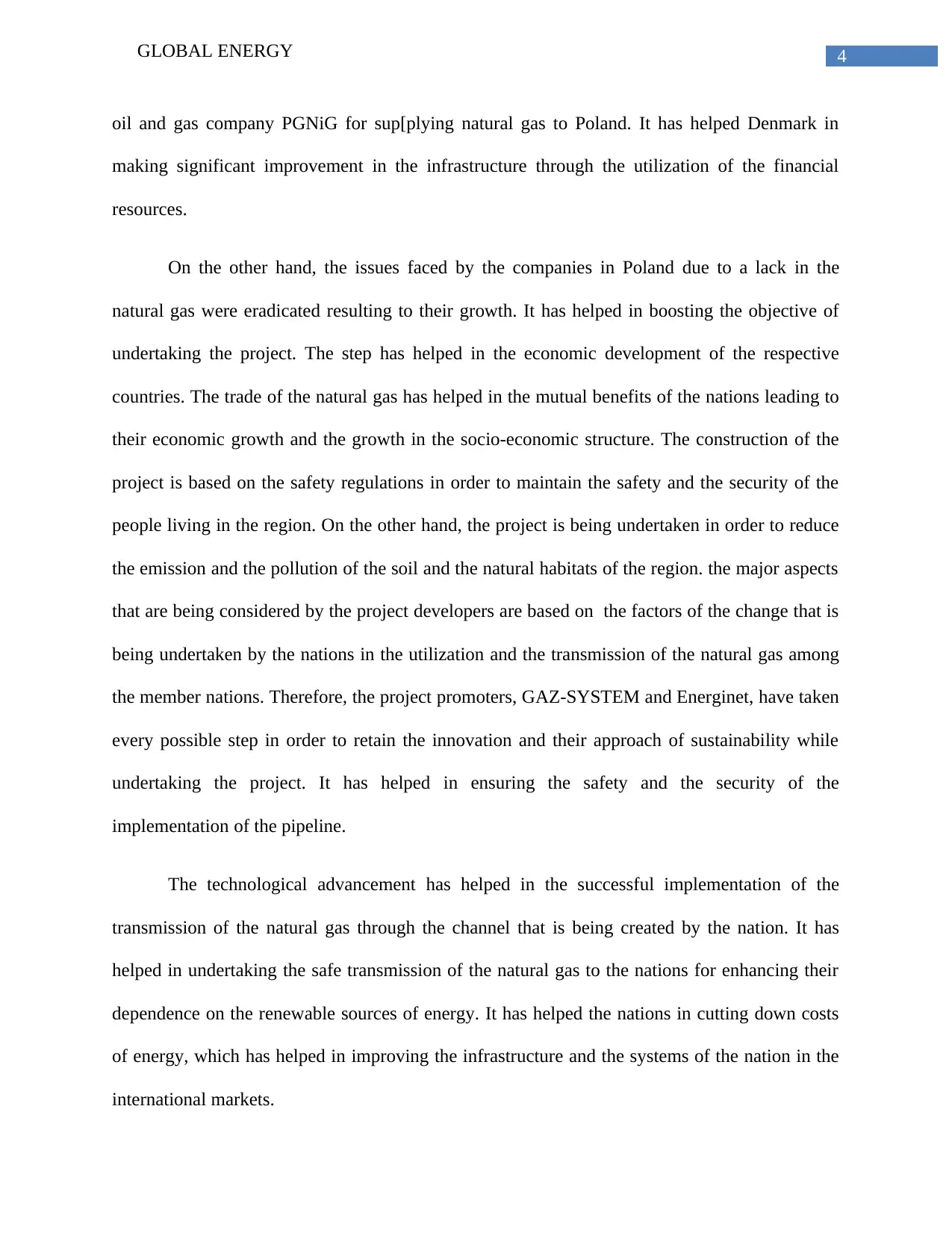
4GLOBAL ENERGY
oil and gas company PGNiG for sup[plying natural gas to Poland. It has helped Denmark in
making significant improvement in the infrastructure through the utilization of the financial
resources.
On the other hand, the issues faced by the companies in Poland due to a lack in the
natural gas were eradicated resulting to their growth. It has helped in boosting the objective of
undertaking the project. The step has helped in the economic development of the respective
countries. The trade of the natural gas has helped in the mutual benefits of the nations leading to
their economic growth and the growth in the socio-economic structure. The construction of the
project is based on the safety regulations in order to maintain the safety and the security of the
people living in the region. On the other hand, the project is being undertaken in order to reduce
the emission and the pollution of the soil and the natural habitats of the region. the major aspects
that are being considered by the project developers are based on the factors of the change that is
being undertaken by the nations in the utilization and the transmission of the natural gas among
the member nations. Therefore, the project promoters, GAZ-SYSTEM and Energinet, have taken
every possible step in order to retain the innovation and their approach of sustainability while
undertaking the project. It has helped in ensuring the safety and the security of the
implementation of the pipeline.
The technological advancement has helped in the successful implementation of the
transmission of the natural gas through the channel that is being created by the nation. It has
helped in undertaking the safe transmission of the natural gas to the nations for enhancing their
dependence on the renewable sources of energy. It has helped the nations in cutting down costs
of energy, which has helped in improving the infrastructure and the systems of the nation in the
international markets.
oil and gas company PGNiG for sup[plying natural gas to Poland. It has helped Denmark in
making significant improvement in the infrastructure through the utilization of the financial
resources.
On the other hand, the issues faced by the companies in Poland due to a lack in the
natural gas were eradicated resulting to their growth. It has helped in boosting the objective of
undertaking the project. The step has helped in the economic development of the respective
countries. The trade of the natural gas has helped in the mutual benefits of the nations leading to
their economic growth and the growth in the socio-economic structure. The construction of the
project is based on the safety regulations in order to maintain the safety and the security of the
people living in the region. On the other hand, the project is being undertaken in order to reduce
the emission and the pollution of the soil and the natural habitats of the region. the major aspects
that are being considered by the project developers are based on the factors of the change that is
being undertaken by the nations in the utilization and the transmission of the natural gas among
the member nations. Therefore, the project promoters, GAZ-SYSTEM and Energinet, have taken
every possible step in order to retain the innovation and their approach of sustainability while
undertaking the project. It has helped in ensuring the safety and the security of the
implementation of the pipeline.
The technological advancement has helped in the successful implementation of the
transmission of the natural gas through the channel that is being created by the nation. It has
helped in undertaking the safe transmission of the natural gas to the nations for enhancing their
dependence on the renewable sources of energy. It has helped the nations in cutting down costs
of energy, which has helped in improving the infrastructure and the systems of the nation in the
international markets.
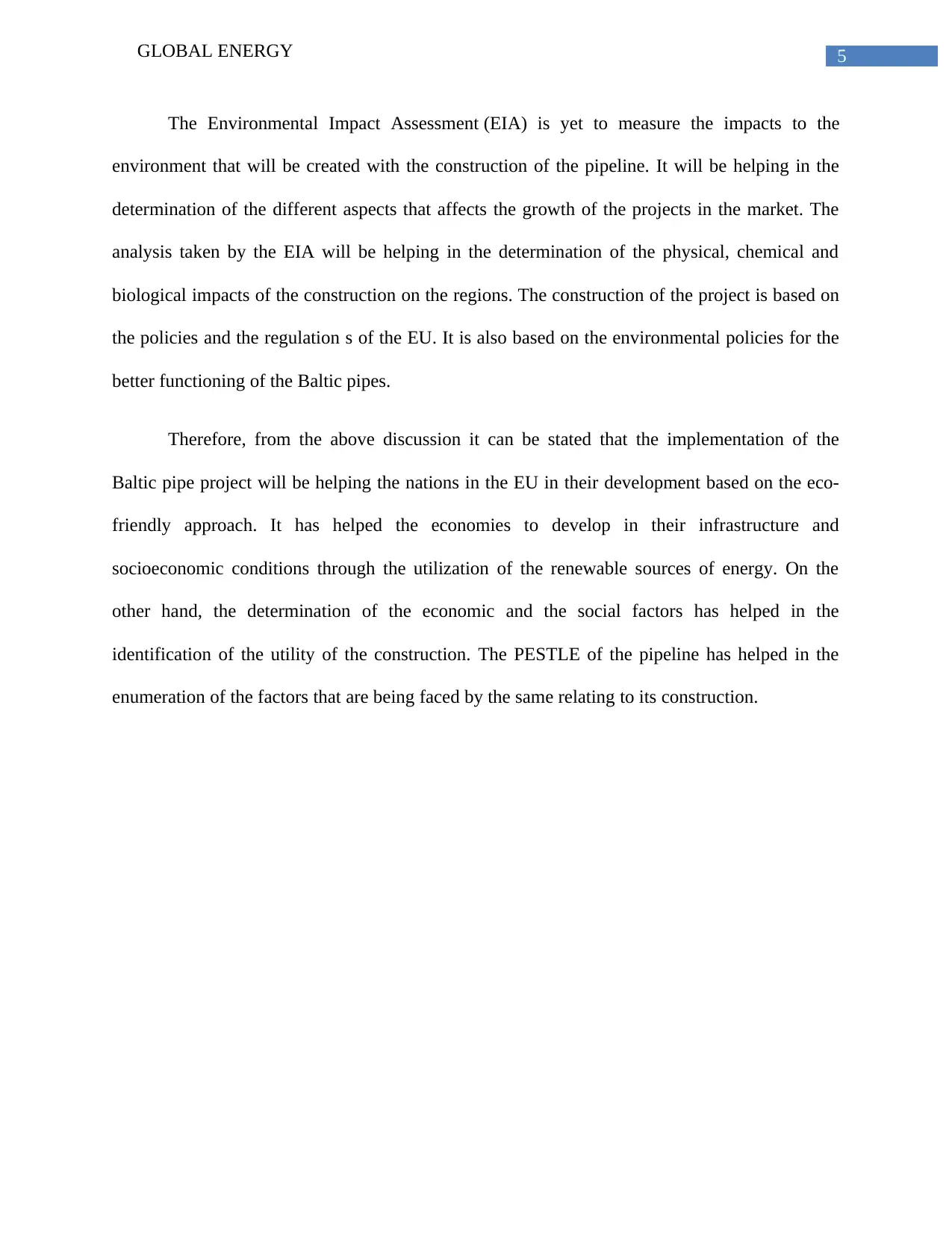
5GLOBAL ENERGY
The Environmental Impact Assessment (EIA) is yet to measure the impacts to the
environment that will be created with the construction of the pipeline. It will be helping in the
determination of the different aspects that affects the growth of the projects in the market. The
analysis taken by the EIA will be helping in the determination of the physical, chemical and
biological impacts of the construction on the regions. The construction of the project is based on
the policies and the regulation s of the EU. It is also based on the environmental policies for the
better functioning of the Baltic pipes.
Therefore, from the above discussion it can be stated that the implementation of the
Baltic pipe project will be helping the nations in the EU in their development based on the eco-
friendly approach. It has helped the economies to develop in their infrastructure and
socioeconomic conditions through the utilization of the renewable sources of energy. On the
other hand, the determination of the economic and the social factors has helped in the
identification of the utility of the construction. The PESTLE of the pipeline has helped in the
enumeration of the factors that are being faced by the same relating to its construction.
The Environmental Impact Assessment (EIA) is yet to measure the impacts to the
environment that will be created with the construction of the pipeline. It will be helping in the
determination of the different aspects that affects the growth of the projects in the market. The
analysis taken by the EIA will be helping in the determination of the physical, chemical and
biological impacts of the construction on the regions. The construction of the project is based on
the policies and the regulation s of the EU. It is also based on the environmental policies for the
better functioning of the Baltic pipes.
Therefore, from the above discussion it can be stated that the implementation of the
Baltic pipe project will be helping the nations in the EU in their development based on the eco-
friendly approach. It has helped the economies to develop in their infrastructure and
socioeconomic conditions through the utilization of the renewable sources of energy. On the
other hand, the determination of the economic and the social factors has helped in the
identification of the utility of the construction. The PESTLE of the pipeline has helped in the
enumeration of the factors that are being faced by the same relating to its construction.
⊘ This is a preview!⊘
Do you want full access?
Subscribe today to unlock all pages.

Trusted by 1+ million students worldwide
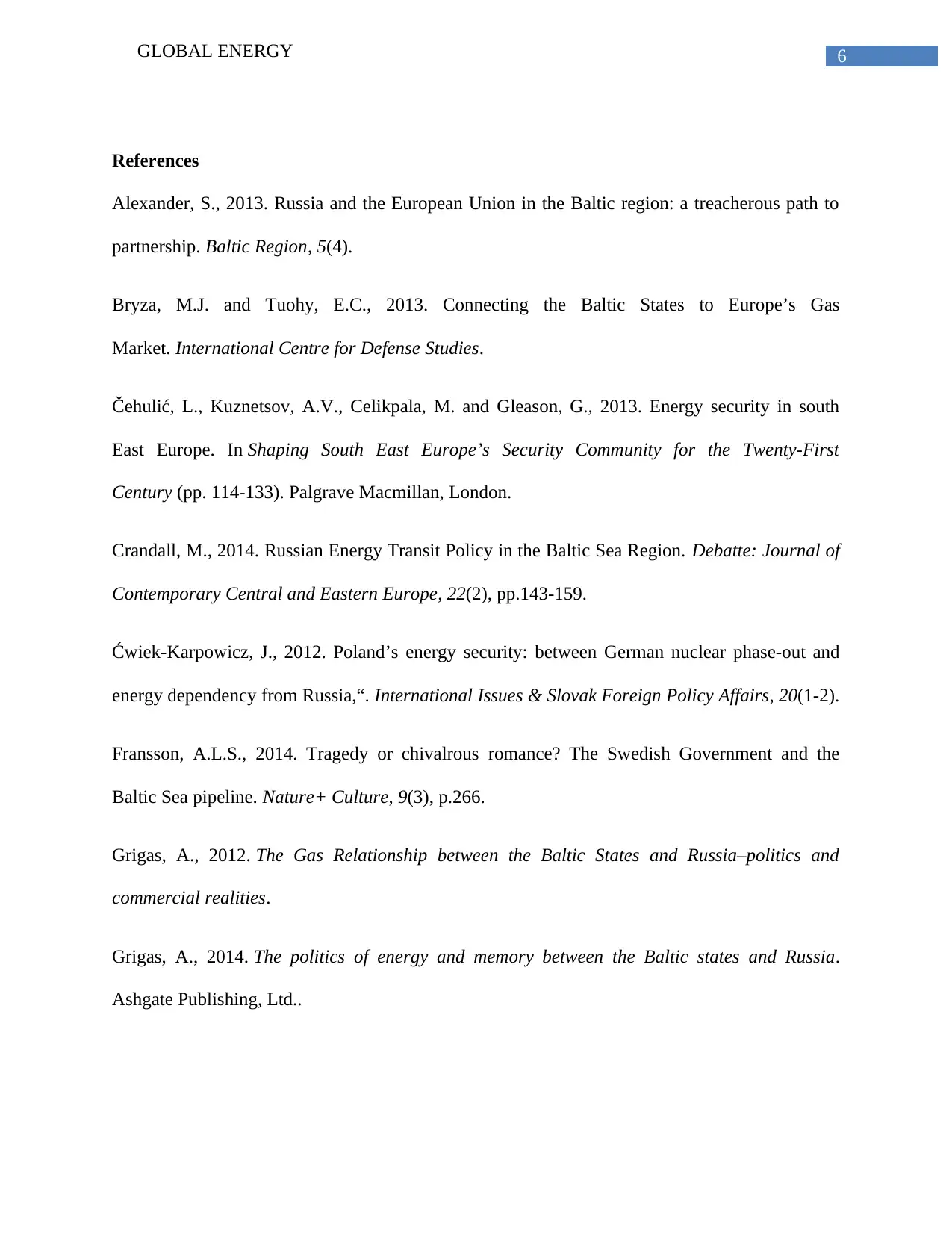
6GLOBAL ENERGY
References
Alexander, S., 2013. Russia and the European Union in the Baltic region: a treacherous path to
partnership. Baltic Region, 5(4).
Bryza, M.J. and Tuohy, E.C., 2013. Connecting the Baltic States to Europe’s Gas
Market. International Centre for Defense Studies.
Čehulić, L., Kuznetsov, A.V., Celikpala, M. and Gleason, G., 2013. Energy security in south
East Europe. In Shaping South East Europe’s Security Community for the Twenty-First
Century (pp. 114-133). Palgrave Macmillan, London.
Crandall, M., 2014. Russian Energy Transit Policy in the Baltic Sea Region. Debatte: Journal of
Contemporary Central and Eastern Europe, 22(2), pp.143-159.
Ćwiek-Karpowicz, J., 2012. Poland’s energy security: between German nuclear phase-out and
energy dependency from Russia,“. International Issues & Slovak Foreign Policy Affairs, 20(1-2).
Fransson, A.L.S., 2014. Tragedy or chivalrous romance? The Swedish Government and the
Baltic Sea pipeline. Nature+ Culture, 9(3), p.266.
Grigas, A., 2012. The Gas Relationship between the Baltic States and Russia–politics and
commercial realities.
Grigas, A., 2014. The politics of energy and memory between the Baltic states and Russia.
Ashgate Publishing, Ltd..
References
Alexander, S., 2013. Russia and the European Union in the Baltic region: a treacherous path to
partnership. Baltic Region, 5(4).
Bryza, M.J. and Tuohy, E.C., 2013. Connecting the Baltic States to Europe’s Gas
Market. International Centre for Defense Studies.
Čehulić, L., Kuznetsov, A.V., Celikpala, M. and Gleason, G., 2013. Energy security in south
East Europe. In Shaping South East Europe’s Security Community for the Twenty-First
Century (pp. 114-133). Palgrave Macmillan, London.
Crandall, M., 2014. Russian Energy Transit Policy in the Baltic Sea Region. Debatte: Journal of
Contemporary Central and Eastern Europe, 22(2), pp.143-159.
Ćwiek-Karpowicz, J., 2012. Poland’s energy security: between German nuclear phase-out and
energy dependency from Russia,“. International Issues & Slovak Foreign Policy Affairs, 20(1-2).
Fransson, A.L.S., 2014. Tragedy or chivalrous romance? The Swedish Government and the
Baltic Sea pipeline. Nature+ Culture, 9(3), p.266.
Grigas, A., 2012. The Gas Relationship between the Baltic States and Russia–politics and
commercial realities.
Grigas, A., 2014. The politics of energy and memory between the Baltic states and Russia.
Ashgate Publishing, Ltd..
Paraphrase This Document
Need a fresh take? Get an instant paraphrase of this document with our AI Paraphraser
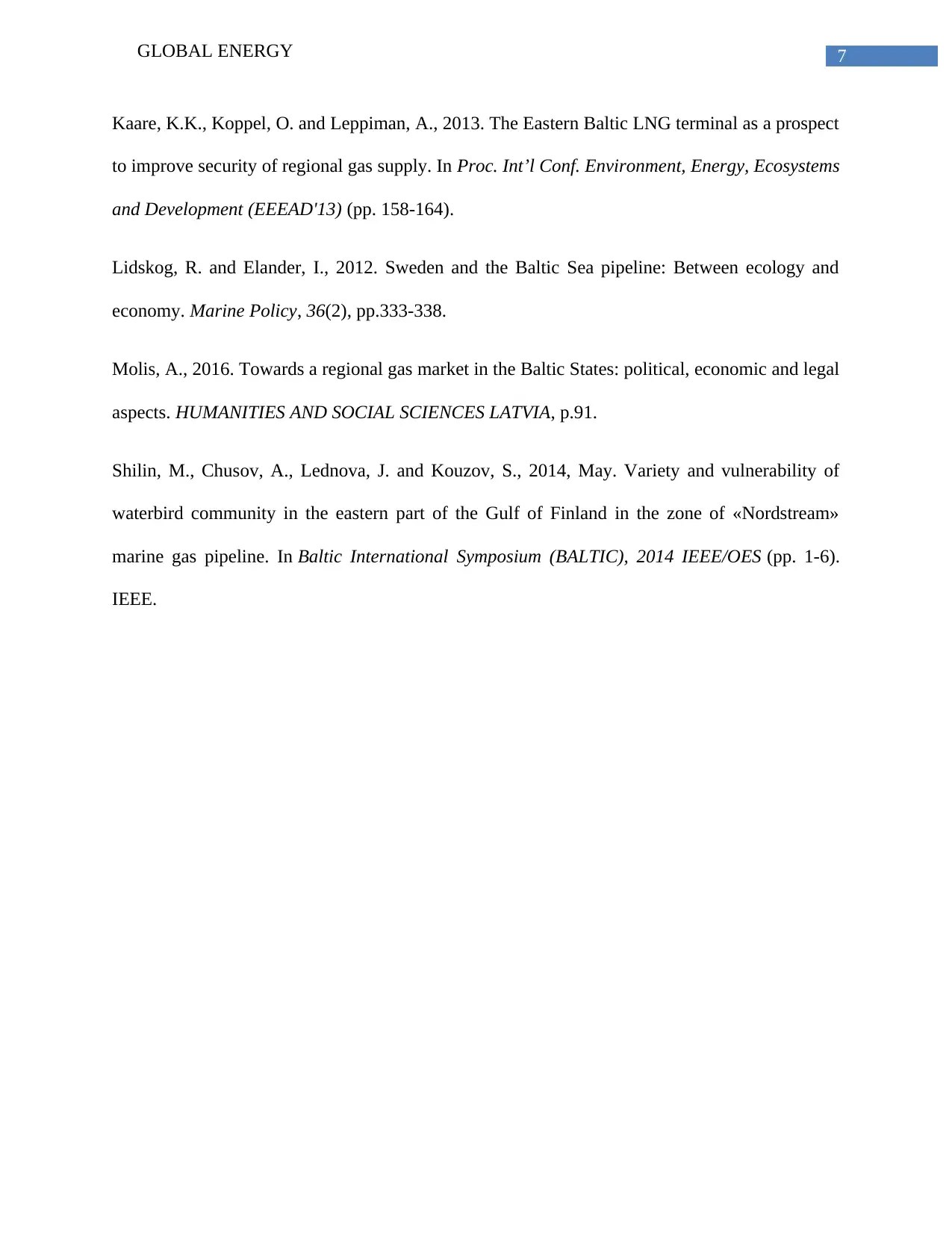
7GLOBAL ENERGY
Kaare, K.K., Koppel, O. and Leppiman, A., 2013. The Eastern Baltic LNG terminal as a prospect
to improve security of regional gas supply. In Proc. Int’l Conf. Environment, Energy, Ecosystems
and Development (EEEAD'13) (pp. 158-164).
Lidskog, R. and Elander, I., 2012. Sweden and the Baltic Sea pipeline: Between ecology and
economy. Marine Policy, 36(2), pp.333-338.
Molis, A., 2016. Towards a regional gas market in the Baltic States: political, economic and legal
aspects. HUMANITIES AND SOCIAL SCIENCES LATVIA, p.91.
Shilin, M., Chusov, A., Lednova, J. and Kouzov, S., 2014, May. Variety and vulnerability of
waterbird community in the eastern part of the Gulf of Finland in the zone of «Nordstream»
marine gas pipeline. In Baltic International Symposium (BALTIC), 2014 IEEE/OES (pp. 1-6).
IEEE.
Kaare, K.K., Koppel, O. and Leppiman, A., 2013. The Eastern Baltic LNG terminal as a prospect
to improve security of regional gas supply. In Proc. Int’l Conf. Environment, Energy, Ecosystems
and Development (EEEAD'13) (pp. 158-164).
Lidskog, R. and Elander, I., 2012. Sweden and the Baltic Sea pipeline: Between ecology and
economy. Marine Policy, 36(2), pp.333-338.
Molis, A., 2016. Towards a regional gas market in the Baltic States: political, economic and legal
aspects. HUMANITIES AND SOCIAL SCIENCES LATVIA, p.91.
Shilin, M., Chusov, A., Lednova, J. and Kouzov, S., 2014, May. Variety and vulnerability of
waterbird community in the eastern part of the Gulf of Finland in the zone of «Nordstream»
marine gas pipeline. In Baltic International Symposium (BALTIC), 2014 IEEE/OES (pp. 1-6).
IEEE.
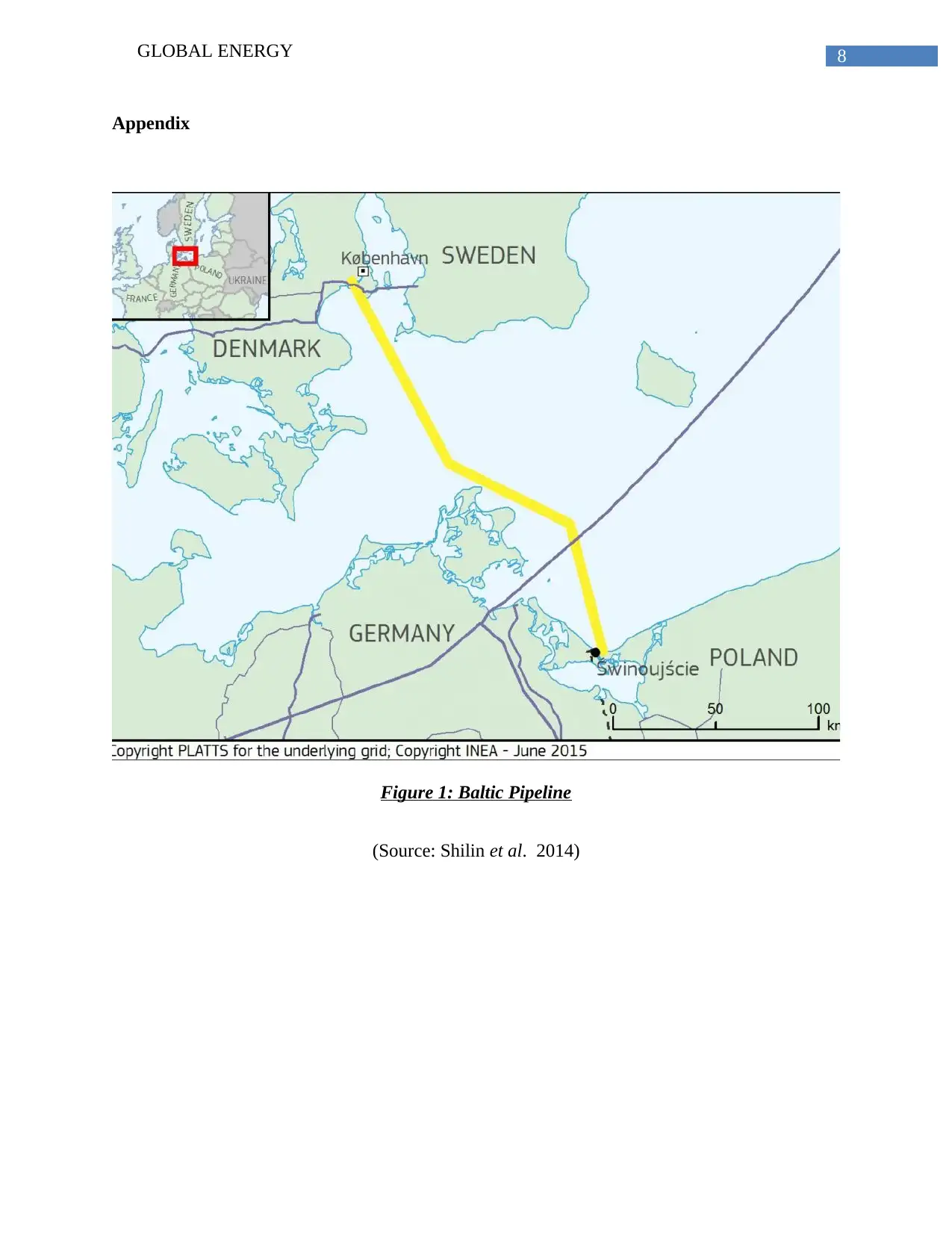
8GLOBAL ENERGY
Appendix
Figure 1: Baltic Pipeline
(Source: Shilin et al. 2014)
Appendix
Figure 1: Baltic Pipeline
(Source: Shilin et al. 2014)
⊘ This is a preview!⊘
Do you want full access?
Subscribe today to unlock all pages.

Trusted by 1+ million students worldwide
1 out of 9
Related Documents
Your All-in-One AI-Powered Toolkit for Academic Success.
+13062052269
info@desklib.com
Available 24*7 on WhatsApp / Email
![[object Object]](/_next/static/media/star-bottom.7253800d.svg)
Unlock your academic potential
Copyright © 2020–2025 A2Z Services. All Rights Reserved. Developed and managed by ZUCOL.





